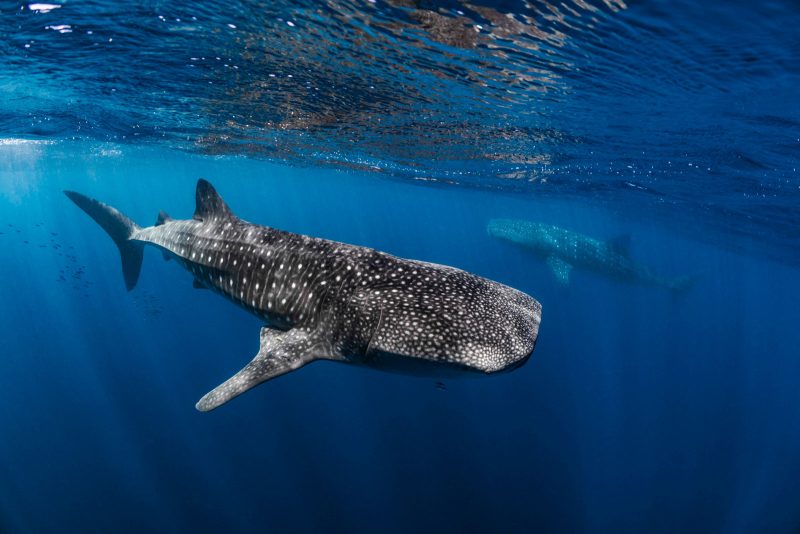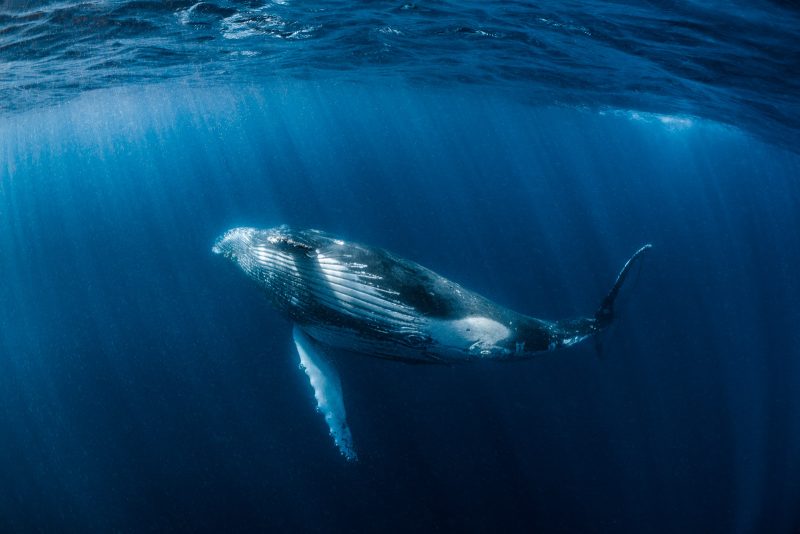Ningaloo Reef Dive Guide for Underwater Photographers

The Ningaloo Reef in Australia’s North West is the world’s longest fringing reef system and offers some of the best opportunities for underwater photography anywhere in the world.
The reef runs along the North West Cape, which is the closest point to where the West of the Australian Continent meets the continental shelf.

The reef’s remoteness, the mixing of oceanic currents, and the strong protection it receives as one of the largest marine parks in Australia mean that it is one of the best places to encounter marine megafauna.
Whale sharks, manta rays, and humpback whales are some of the main attractions for photographers visiting Ningaloo, but there is more than just the big fish to see here.
On the eastern side of the cape lies the Exmouth Gulf, where you can dive the Exmouth Navy Pier, one of the best shore dives in the world.
With a huge abundance of fish life and great macro subjects, it’s a must-do for underwater photographers.
1. Whale sharks
The Ningaloo is probably most famous for its whale sharks, which aggregate on the reef from mid-March until about August (though with some luck, they can be encountered year-round).
The best way to meet one of the whale sharks is through an organized tour. There are 15 boats running tours throughout the season: 12 in Exmouth and 3 in Coral Bay.
All the boats include reef snorkels, whale shark swimming, and a spotter aircraft to find the wildlife, so there is a very good chance to see them during the season.

As for much of the underwater photography on the Ningaloo, I would recommend a fisheye lens or a wide-angle converter.
Much of the photography you’ll be doing is with big animals up close, and a fisheye helps to create those dramatic images of big fish. A fisheye will also help with visibility, which is often a bit average here – lots of filter feeders mean lots of food in the water.
With a fisheye, you are closer to your subject, so there is less water and fewer particles between you and the subject.
Photographers are often chasing top-down shots of whale sharks to capture that gorgeous pattern. But swimming with the sharks on the Ningaloo is strictly regulated, and we aim for there to be as little disturbance as possible to the animals.
Whale shark photography is always done while snorkeling. Some of the rules to be aware of include that you must always maintain a distance of at least three meters from the animal (four meters from the tail) and that photographers can’t use any artificial lights.

That means the best way to get that top shot is to wait for the shark to dive. Then, on its ascent, position yourself behind it so you can get the whole animal in the frame without swimming on top of it.
They usually don’t swim too fast, so you can use a shutter speed of around 1/200 fps and a smaller aperture to help capture the light rays falling through the water.
Read more: 8 Tips for Freediving Underwater Photography
2. Manta rays
Manta rays are another one of the main attractions of the Ningaloo, which is one of the few places where you can encounter both reef and oceanic mantas in the same location.
To meet the mantas, you’ll need to head to Coral Bay, about one and a half hours south of Exmouth, where a year-round manta population resides in the bay.
Again, the best way to see them is with a guided tour, which departs daily from Coral Bay and also uses an aircraft to find the best mantas to swim with.
I would recommend a fisheye lens for shooting in Coral Bay, as the mantas are often feeding in the bay, which can be shallow and full of plankton.

Like whale-shark interactions, manta swims are also subject to strict license conditions to minimize the impact of tourism on the animals.
It can be really tempting to dive down in front of the rays for a belly shot, but this is usually discouraged as it affects their swimming and feeding behavior.
Luckily, they often swim over shallow sand in Coral Bay, so you can get some great top shots with the contrast of the black rays over white sand.
If you are lucky, they might also be barrel roll feeding if the food is dense enough, giving you the perfect opportunity for a belly shot without disturbing the animal.
Read more: 8 Tips to Create Beautiful Underwater Animal Portraits
3. Humpback whales
Humpback whales also migrate up the Ningaloo coast in huge numbers during the winter months, and it is one of the few places where you can swim with and photograph these huge animals in the water.
Humpback whale swimming must be done through a tour, as it is illegal to swim with any marine mammals in Australia without a permit. Not only can you receive large fines for doing so, but it is also dangerous.
Humpbacks are fight-or-flight animals and will defend their calves if they feel the need to.
Be aware that photographing humpbacks in the water on the Ningaloo can be hard work, so if you aren’t a confident and strong swimmer, it may be better to observe the show from a boat.
However, if you do want to give it a go, it can be one of the most special and rewarding experiences of your life.

Photographing the whales can be really difficult. They are huge, intelligent, and fast-swimming animals.
They have really dark dorsal sides, but most of the whales in the West Australian population have a completely white underside and pectoral fins, sometimes more. This means they can totally blow out your exposure.
I’d recommend stopping your camera down more than you think you need to. It is always easier to add exposure in post than trying to save an overexposed shot of a “glowing” whale.
You will also be snorkeling here, and the best way to have a good interaction with the whales is to let them come to you, remain as still as you can in the water, and try to stay quiet.
That way, the whales will be more relaxed, and you’ll have a better chance of getting that perfect shot.
Read more: How to Photograph Humpback Whales Underwater
4. Exmouth Navy Pier
A visit to the Ningaloo wouldn’t be complete without diving the Exmouth Navy Pier. This is one of the best shore dives in the world.
Although the site is small, the concentration of marine life is mind-blowing. Huge schools of trevally swirl around the pillars, gigantic Queensland grouper roam amongst the fish, and during the season (June-October), grey nurse sharks hover ominously over the bottom.
Note that the site is an active military base and must be explored with a tour operator. There are also strong currents, so if you aren’t confident, it is a good idea to have a dive guide.

There are also a lot of macro photography opportunities on the site, with different nudibranchs, octopus, and frogfish to shoot.
This is one of the reasons wearing two tanks is the way to go, but if you are limited to lenses, again I’d recommend a fisheye or at least a wide angle. Fisheye works perfectly here with close-focus wide-angle shooting available.
This is also one of the only dives where you will need strobes, as they will really help with the darker water of the gulf beneath the pier.
Read more: How to Choose a Strobe for Underwater Photography
5. Ningaloo Reef snorkeling
One of my favorite things about photographing the Ningaloo is its accessibility. If you don’t want to spend a lot of money on a tour, there are lots of great snorkeling opportunities from the shore.
Most of the shore snorkeling sites like Turquoise Bay and Oyster Stacks will give you the opportunity to photograph turtles, healthy coral, and lots of different reef fish.
Beyond the famous sites, there are almost 300 kilometers of coastline to explore if you have a four-by-four vehicle.

There are plenty of amazing spots to camp and snorkel. Some of my favorites are North Mandu, Warroora Station, and Winderabandi Point.
If you have your own boat or even a kayak, you’ll be able to explore a little further, and you never know what you are going to find on the Ningaloo!
Read more: 8 Essential Skills and Techniques for Underwater Photographers
Extra gear to bring
A decent set of snorkeling gear is essential! It is possible to rent, but you will be much more comfortable and able to spend more time in the water with gear that fits well.
For photographing any marine megafauna, you will also want good fins – big fish don’t usually swim very slowly!
It’s worth bringing a telephoto lens, especially during humpback season, as there are lots of cetaceans here, and you won’t want to miss out on photographing them.
It is possible to photograph the whales from shore but to get closer, it is better to see them by boat, and a number of whale-watching tours run throughout the season.
Read more: What Equipment Do You Need for Underwater Photography?
In conclusion
Of course, the big draw for most underwater photographers visiting the Ningaloo Reef is the marine megafauna, but I feel like there is something here for everyone, and the accessibility makes it perfect for someone wanting to learn underwater photography.
In fact, as many of the sites are shallow, and most of the time you are shooting at the surface, a lot of photographers here use a camera surf housing with a fisheye lens. This can be a much more affordable setup for someone starting out in underwater photography.
If Ningaloo wasn’t already on your bucket list, it should be!





